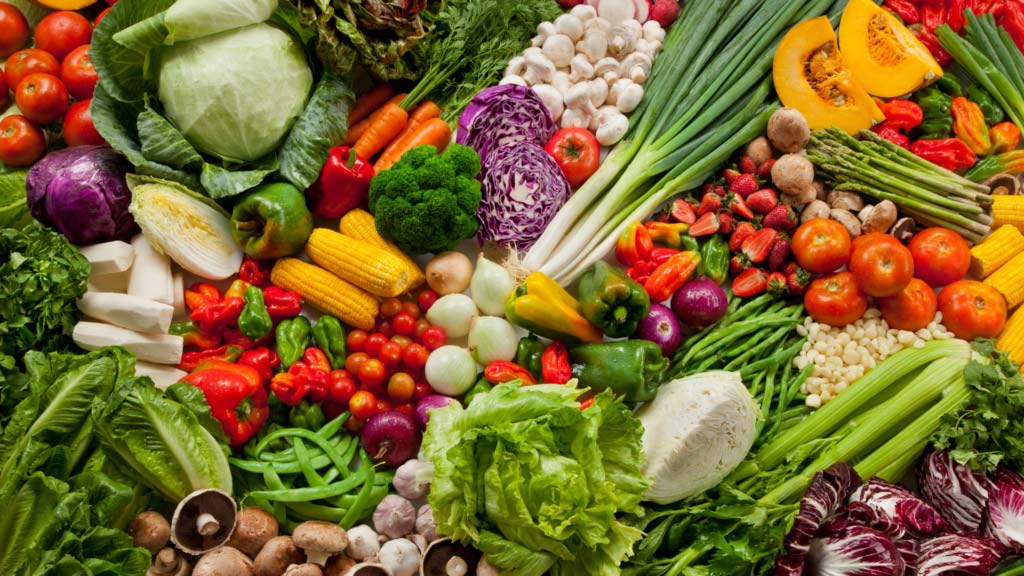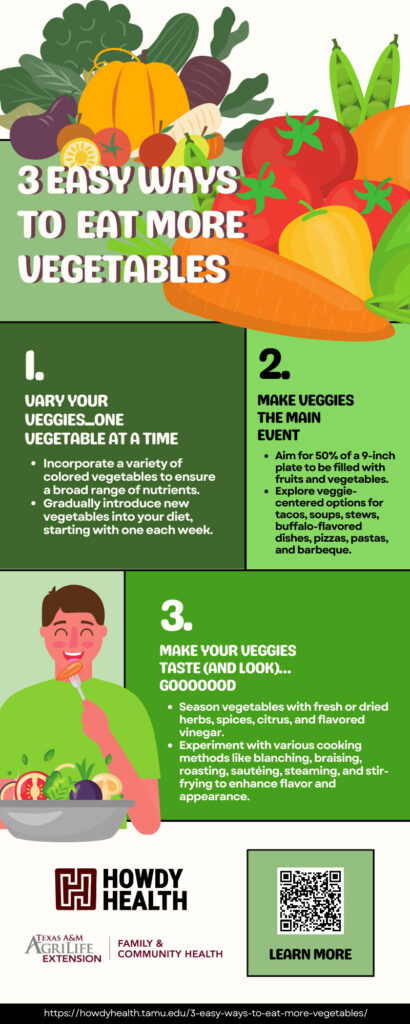Vegetables are rich in many essential nutrients vital for the health and maintenance of the body, and most are naturally low in fat and calories1 – making them a great choice for weight control. The Dietary Guidelines for Americans organizes vegetables into the following 5 categories based on their nutrient content:
- Dark green
- Red and orange
- Beans, peas, and lentils
- Starcy
- Other vegetables.2
You should try to include vegetables from all 5 categories as part of a healthy diet. Learn how to eat more vegetables with these 3 tips:
1. Vary Your Veggies… 1 Vegetable at a Time
Add a variety of colored vegetables. By varying the vegetables you eat, you are more likely to get the nutrients your body needs to thrive. If you don’t eat many vegetables or you’re used to eating the same few veggies, try adding just one new vegetable each week. This doesn’t need to be an overwhelming process. Do what works for you. If you need ideas about what type of vegetable fits into each category, you can refer to the MyPlate Food Group Gallery. Make a meal plan for the week, incorporating one new vegetable.
2. Make Veggies the Main Event
Don’t let vegetables take the back seat. Even if you have to just heat a can of green beans or throw together a bagged salad to get veggies on the table – there’s nothing wrong with that – we all need easy ways to add veggies sometimes. It’s important to recognize, however, that vegetables should be making up a significant portion of our diet. If you look at a 9-inch plate, 50 % of it should be filled with fruits and vegetables, while the remaining should hold a portion of whole grains, and a small portion of protein foods.1 You don’t have to give up your favorite tasty tacos, buffalo bites, hearty soups and stews, pizzas, pastas, or even burgers and barbeque. Try some of these veggie-centered options:
- Tacos: Say yes to Taco Tuesday with lentil, tofu, cauliflower, butternut squash, or southwest veggie tacos. You can find a myriad of vegetable tacos with an online search. Top them off with pickled onions or jicama slaw.
- Soups & Stews: You can enjoy many veggie-centered soups and stews without giving up richness or flavor. Try bean and veggie chili, corn chowder, coconut curry, lentil stew, miso soup with greens and tofu, vegetable gumbo, vegetable minestrone, or vegetable pho to name just a few. Keep a variety of frozen vegetables in your freezer and add extra vegetables whenever you can.
- Buffalo-flavored Favorites: Don’t miss out on your game-day favorites. Try buffalo flavored veggie delights such as cauliflower bites, buffalo bean and grain bites, buffalo roasted chickpeas, buffalo tofu “wings,” double-stuffed buffalo-flavored potatoes,
buffalo chickpea pizza, or buffalo falafel pitas. Just do a search for buffalo flavored vegetable recipes to find something fun to try. - Pizza: Grab a cauliflower pizza crust from your local store or try your hand at making one. Search online for green pizza crust recipes, which will turn up a variety of veggie-based pizza crust options. Top your pizza crust with vegetables. Consider fresh herbs and out-of-the-ordinary toppings like artichoke hearts, arugula, basil, cilantro, eggplant, heirloom tomatoes, spinach, or zucchini. Vary your tomato sauce – Choose barbeque sauce, curry, harissa, herbs-garlic-olive oil, pesto, or tapenade.
- Pastas & Noodles: Choose whole grain pasta or grab yourself a new kitchen gadget – a spiralizer – and make veggie noodles; or just check the freezer section in your grocery store for a myriad of noodle options. Try beet, butternut squash, carrot, cucumber, kohlrabi, radish, sweet potato, spaghetti squash, summer squash, or zucchini noodles. Top them with a generous portion of roasted vegetables.
- Barbeque & Burgers: Use tempeh, tofu, eggplant, or mushrooms atop your smoker or grill to give you that smokey barbeque flavor. Shred veggies like carrots, parsnips, radishes, sweet potatoes, turnips, or zucchini, and cook them in your favorite barbeque sauce to make a “pulled” veggie sandwich. Also, try barbeque baked beans or a barbeque bean soup as a veggie-licious option. Don’t forget the burgers. Try black bean (or other bean), lentil, portobello mushroom, or sweet potato burgers.
Veggies don’t have to take the back seat – they can be the main event.
3. Make Your Veggies Taste (and look)…Gooooood
Only about 1 in 10 American adults consume the recommended 2–3 cup-equivalents of vegetables each day.3 Many don’t think they taste very good – or at least not as good as what we choose over them. Some ways to change that include –
- Seasoning your veggies with fresh or dried herbs, a variety of dry spices, a squeeze of citrus – consider lemons, limes, oranges, or grapefruit, and a splash of wine or flavored vinegar.
- Trying a new cooking method that can bring out the color and flavor of your vegetables. Some healthy cooking methods include:
- Blanching – Cook your vegetables in boiling water for 1-3 minutes and then quickly transfer them to ice water to stop the cooking process. This process helps maintain their color and nutrients.
- Braising – Gently simmer vegetables in a small amount of liquid (water, broth, juice, wine) in a covered pot or skillet until everything is tender. You can add flavor by adding herbs and seasonings to the liquid. Braising is best for vegetables that take longer to cook like beets, carrots, leeks, or potatoes.
- Roasting – Roast your veggies at a fairly high temperature, usually at about 375 degrees or higher. Browning or caramelization, brings out the natural sweetness present in vegetables.
- Sautéing – Cook your vegetables in a skillet for a short amount of time using a small amount of healthy fat, like olive or canola oil, rather than butter or lard. Sautéing enhances the flavor and texture of vegetables and may make them
more appealing than their raw form. Try sautéing asparagus, onions, and mushrooms. - Steaming – Steam your veggies using a steamer basket over boiling water in a covered pan or skillet. It preserves your vegetables color, flavor, and texture, as well as their nutrients. Steaming is especially good for green vegetables, like broccoli and green beans.
- Stir-frying – Cook vegetables with a small amount of broth, oil, or non-stick spray at high heat, and tossing them constantly. This is traditionally done in a wok, but you can also use a heavy skillet. Cook until the vegetables are just a bit tender, but still crisp.
Want some more ideas for getting healthy? Check out all our free Howdy Health programs to step into the habit of healthy.
Infographic
Download the PDF or share the image below to learn how to eat more vegetables.
- U.S. Department of Agriculture. MyPlate.gov. Accessed October 2, 2023. https://www.myplate.gov/
- U.S. Department of Agriculture and U.S. Department of Health and Human Services. Dietary Guidelines for Americans, 2020-2025. 9th Edition. Accessed October 9, 2023
- https://www.dietaryguidelines.gov/sites/default/files/2020-12/Dietary_Guidelines_for_Americans_2020-2025.pdf
- Lee SH, Moore LV, Park S, Harris DM, Blanck HM. Adults Meeting Fruit and Vegetable Intake Recommendations – United States, 2019. MMWR Morb Mortal Wkly Rep. 2022 Jan 7;71(1):1-9. doi: 10.15585/mmwr.mm7101a1
- U.S. Department of Agriculture. Ask USDA. July 17, 2019. Accessed October 12, 2023. https://ask.usda.gov/s/article/What-counts-as-a-cup-of-vegetables





